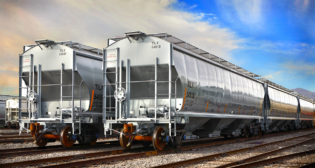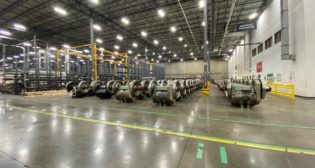
NTSB: How Not to Blow a Gasket
Written by William C. Vantuono, Editor-in-ChiefThe National Transportation Safety Board has released findings and safety recommendations on DOT-117 tank cars that address the performance of gaskets employed in sealing manway covers and valves in a derailment, and how tank construction—specifically, welds—may contribute to gasket failures.
NTSB’s findings stem from the Jan. 8, 2022 derailment of eastbound BNSF train U JOENYF7 07A (photo below) at milepost 156.2 on the Red River Division in Oklaunion, Tex. Derailment of 37 DOT-117Js (built new, not 117R retrofits) resulted in ethanol igniting and burning uncontrolled for about four hours in a pool fire. No injuries or evacuations were reported. The train, with two crew members on board, consisted of two head-end locomotives, one DP (distributed power) locomotive at the rear, two buffer railcars, and 96 loaded DOT-117Js carrying denatured ethanol. BNSF estimated that 601,819 gallons of denatured ethanol released from 28 of the 37 derailed tank cars. (NTSB’s findings do not address the derailment’s probable cause.)

NTSB reported that most of the ethanol that was released leaked from manway covers and bottom outlet valves that remained intact during the derailment but sustained damage from the pool fire. “We found that the gaskets used in the service equipment were made of materials that are vulnerable to damage when exposed to fire,” NTSB said. “Using gaskets made of more thermally resistant materials would likely increase the survival time of tank cars exposed to fire and reduce the severity of hazardous material releases. We also found that when PHMSA (Pipeline and Hazardous Materials Administration) created the DOT-117 specification, which includes the DOT-117J, for non-pressure tank cars, it expanded existing thermal protection regulations for pressure tank cars to non-pressure tank cars with different designs.
“Further, we found that a mechanical (non-thermal) breach of a tank car involved in the derailment occurred because of loading between underframe components and tank head material—an outcome that a specific federal regulation and an industry standard, the Association of American Railroads 85% rules, are intended to prevent. This load scenario likely occurred because several of the tank car’s welds exceeded the sizes specified in the design, which led to the tank head material being the weakest point in the load path and fracturing, releasing lading.
“Further, because there is not an industry standard for rejecting an oversized weld, the design size for each weld is effectively a minimum size, and that as-built tank cars may have oversized welds that may lead to tank fractures. Relatedly, we found that a design that complies with the 85% rules does not prevent fabrication of tank cars that may violate the rules because of oversized welds that make the tank cars more vulnerable to tank fractures in a derailment.”
NTSB Specific Findings
- “Gaskets currently used in DOT-117 tank car service equipment may be made of materials vulnerable to thermal damage when exposed to fire, which can lead to the release of hazardous material.
- “Using gaskets with higher service and survival temperatures would likely increase the fire exposure survival time of DOT-117 tank car service equipment in flammable liquid service and reduce the severity of hazardous materials releases.
- “PHMSA’s 2016 expansion of existing thermal protection system regulations from pressure tank cars to non-pressure DOT-117 tank cars likely did not account for the design differences between these types of tank cars, thus a DOT 117 tank car certified as compliant with regulations may have deficient thermal protection because its service equipment may not be protected by its thermal blanket.
- “The mechanical breach of tank car TILX731751 between the tank head material and the front sill pad occurred because the window weld between the front sill pad and the tank continued to provide a load path between the tank head and the stub sill while the head brace remained attached to part of the front sill pad, leading to a local stress state that exceeded the strength of the tank head material.
- “Because welds between the head brace and front sill pad exceeded their design sizes, the strength of the head brace attachment weld for tank car TILX731751 likely exceeded the load carrying capability of the underlying front sill pad, reducing the probability of the weld failing as intended when placed under high loads, such as the ones that occur during a derailment, and resulting in the tank car being mechanically breached.
- “The weld size specified by a tank car design is effectively a minimum size for the weld on an as-built tank car because industry standards do not provide for the rejection of oversized welds that, if left unaddressed, may lead to tank fractures.
- “A tank car design that complies with the ARR’s 85% rule does not prevent tank cars from being fabricated with oversized welds that make the as-built tank cars noncompliant with the rule and more vulnerable to mechanical breaches in a derailment.”
NTSB Recommendations
NTSB said FRA (Federal Railroad Administration) and PHMSA should collaborate “to develop and publish benchmarks, thermal performance standards and survival temperatures for gaskets to be used in tank cars used in flammable liquid service that reflect currently available gasket materials, and that address both accident and normal transportation conditions.” Further, FRA and PHMSA should “revise the DOT-117 specification in 49 Code of Federal Regulations 179.202-6 to ensure that DOT-117 tank cars incorporate thermal protection systems appropriate to non-pressure tank cars so that service equipment is thermally protected.”
NTSB said the AAR needs to “update its Certificate of Construction approval procedures to ensure that tank cars comply with this revised specification. We also recommended that the AAR, after PHMSA revises the DOT-117 specification, revise the inspection requirements for welds associated with the 85% rule contained in the Manual of Standards and Recommended Practices to include a standard for rejecting oversized welds on as-built tank cars.”



